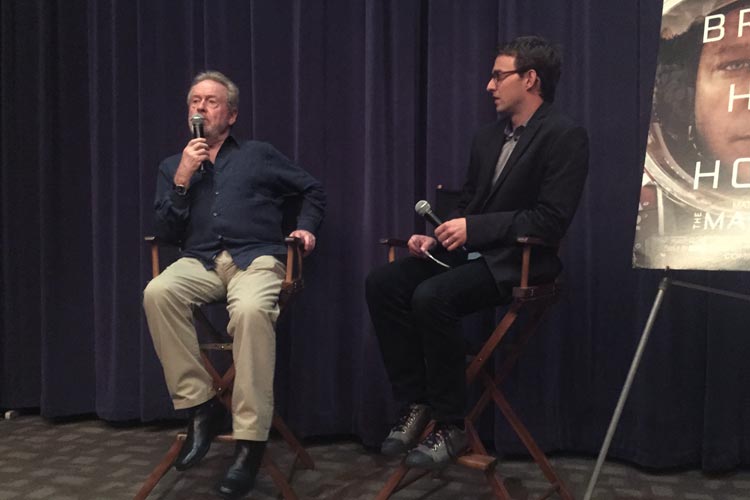The following questions and answers are excerpted from a conversation that followed the NBR screening of The Martian.
Can you discuss the story’s source?
Ridley Scott: Andy [Weir] was one of these—he calls himself a geek, so I’ll call him a geek—who would…I’m not very familiar with it, you do it on web, write chapter by chapter, and gradually you gain an audience. Either you get dismissed or you suddenly have fans, and much to his surprise he had quite a few fans out there. He had done ten chapters; they’re all waiting for the next installment. As he got into it, the next call he got was from 20th Century Fox. He thought, Somebody’s joking. Then the next call he got was from the screenwriter, Drew Goddard. Andy thinks, Now someone’s really conning me.
“Every now and again one of them would start to suffocate”
You used classic filmmaking techniques, especially in the opening scene. Can you talk about shooting it?
Scott: These storms are absolutely disgustingly filthy, and we had real fifth in the air. You have a real mix of dust. If you have too much dust, you’re going to kill the picture. So you need just enough dust being chipped through those fans, as well as hard objects, fragments—I use vermiculite. Then, on top of that, it still does not look like enough stuff, so I add a layer of digital effects. But whichever way you look at it, it’s filthy. But the actors are okay because they’re inside a suit with a helmet on, and they’re not breathing it in.
You put all your cast in those suits and just pelted them with debris?
Scott: Yes, but they like it, that’s what they do. Then I put a rope around them and so basically make it more difficult. I got a guy completely covered in black in the storm, so if you look carefully in the background—you won’t be able to see him because they can’t be seen—but as they’re trying to walk forward and act, I got another guy yanking and dragging them randomly so they don’t know what to expect. It’s just like getting hit with a gust of wind. That helps. You learn a little bit each time, every time you do something. The first time I ever did it was in Alien. That was one camera in those days. We would just chuck as much vermiculite as we could, except in those days we hadn’t engineered the helmets so well, so every now and again one of them would start to suffocate and you’d have to run around in circles trying to get the helmet off.
You also had to use different devices to tell the story given that he’s alone so much.
Scott: We had to figure out how to do something, because whatever you do, whoever it’s from, voiceover is going to become tedious, and you can’t do voiceover for the entire film. The last thing I wanted was voiceover in this. I wanted him to be speaking to himself, and therefore how do you justify that: you create the black box that any piece of equipment like this would have, the environment—his habitat, which is where he is living—in that there be twenty or thirty GoPros in every corner of the place. For me that’s logical, because if that thing popped, and he died, they’d want to know when, where, and how, and the reason why he died. So it would all be recorded, so whoever went back there would find the body and go in and run the black box, which is what it is, and see what happened. The cameras then become companions. He’s doing his thing, cooking his dinner, and then he suddenly refers to the camera as if it’s a buddy. So suddenly his whole intonation changes, this enables us to have a different variation on tone, tonality, and voiceover. But the face in the voiceover became very clear; it was the fundamental basis for a lot of the humor.
Can you talk about the 3D in this film?
Scott: I love 3D. The only drawback with 3D is whatever we do, certainly in the foreseeable future, I think you’re going to have to wear glasses, which is kind of a pain. It’s not a problem. It’s part of the process. But I do love 3D, and I think this is particularly good 3D here working with Dariusz Wolski. This is my fourth film with Dariusz and his team. We shoot 3D, we edit 3D. It’s not a problem, because both Dariusz and I are very visual, we can talk about that and line up very fast, and just say, “Go for it.” I don’t like when you shoot 2D and then you have to go 3D. That can add a lot of money to the budget. If we shoot 3D, it’s great!

